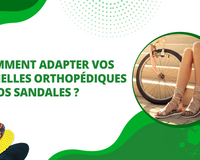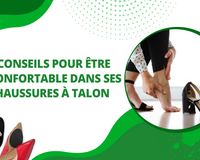
Flatfoot is a common condition in children and adults, which can lead to flatfoot pain and movement difficulties. It can be congenital or acquired, and must be diagnosed and treated by a health care professional before it worsens.
However, since this plantar morphology does not cause any problems (if it is not associated with pain)However, since this plantar morphology doesn't cause any problems if it's not associated with pain), it must be acknowledged that almost one person in two has a flatfoot.
However, if this morphology is associated with pain, the use of a made-to-measure flat-foot orthotic insole in addition to a pair of flat-foot orthopedic shoes can avoid the need for surgery. From now on, Smarfeet gives you more details on the diagnosis and treatments available for flatfoot pain.
Definition of flatfoot

A flatfoot is a foot condition where the arch collapsesIn some cases, this can lead to flatfoot pain and instability when walking. In such cases, flatfoot can be described as "pathological".
However, this type of foot can also be called "idiopathic" when it does not require intervention, even though 40% of the adult population has this type of foot.
When it is a pathology, however, specific treatment may be recommended to limit foot complications and relieve flatfoot pain..
Major causes of flat foot
Flatfoot is a very common plantar problem in adults and children. It is characterized by abnormal foot posture, which can lead to muscle and joint pain. In adults, there are various causes, the most frequent being :
- weight gain
- Overuse of foot muscles
- Fragility of the ankle, heel or Achilles tendon.
- Aging
- Neurological diseases
- Rheumatic diseases and certain genetic disorders.
Possible complications of flat feet
If flatfoot pain is left untreated, the pathological consequences can become very disabling, leading to a number of complications such as :
- Morton's Neuroma
- Tendonitis
- Hallux valgus or hammertoes
- Extreme pain in knees, feet, hips and ankles
- Plantar fasciitis
How is flatfoot diagnosed?

In children, flatfoot diagnosis can only reveal positive results from the age of three, because if it is carried out before then, it may prove to be false due to the large volume of the plantar cushion.
However, it is important to know that a consultation may only be necessary if flat feet are pathological and not idiopathic in nature, since in the former case they are accompanied by intense pain and even functional disorders.
However, in both cases, i.e. when qualified as idiopathic, flat feet are asymptomatic and do not give rise to any particular complications.
During the diagnosis of flatfoot, the depth of the inner arch of the foot is measured using a podoscope, and the doctor or specialist podiatrist assesses the level of severity of the flatfoot on the basis of the result obtained.
However, there are many symptoms that can help diagnose flatfoot:
- abnormal deterioration of footwear at heel level
- Abnormal displacement of the talus
- Heel and valgus imbalance.
- A large footprint due to arch collapse.
How to cure flatfoot?

As mentioned above, if flatfoot is associated with pain, it can lead to serious complications. There are several possible treatments for flatfoot pain:
- Home stretching exercises or physiotherapy
- The use of orthopedic insoles for flat feet
- The use of adapted shoes with wide, thick soles and arch support
- Surgical intervention
Physiotherapy and home exercises
In addition to wearing flat-foot insoles, physiotherapy can be a very useful treatment for relieving flat-foot pain and preventing injury. Exercises to strengthen and stretch the muscles and ligaments of the foot can also help to relax the arch of the foot, à relieve flatfoot pain and correct posture.
However, it is very important to talk to a qualified physiotherapist for practical advice on the most appropriate exercises and treatment.
Wearing orthopedic insoles for flat feet

Flat-foot orthotics can also help relieve pain and correct posture in children and adults suffering from flat-foot pain. Made-to-measure, a flat-foot insole offers extra support to the arch of the foot and helps keep the foot in the correct position.
✅ However, it's important to choose the best flat foot orthotics for the best results.
Using the right flatfoot shoes
A flat-foot shoe is essential to prevent injury and relieve pain. The shoe should be wide enough and have a thick, wide flat-footed sole to allow the toes to move freely and provide good support for the arch of the foot.
So, it's best to opt for a shoe for flat feet or orthopedic flat-foot shoes that offer arch support
Flatfoot surgery: an essential solution
In the most extreme cases, surgery may be required to relieve flatfoot pain. However, before opting for flatfoot surgery, it is advisable to consult a qualified physician before making this decision.
While flatfoot surgery may solve the problem in the long term, it can also entail risks and side effects, even though its aim is to restore the foot to its natural function. However, several types of operation can be performed, depending on the stage of the pathology and the associated deformity:
- Surgical intervention or conservative surgery, which maintains the mobility of the foot joint.
- Surgical intervention or non-conservative surgery, which aims to partially or totally block the foot joint in its natural position.
Who to consult for flat feet?

If you're suffering from flatfoot pain, it's important to consult a general practitioner. Your general practitioner will refer you to the appropriate specialist who can help you diagnose the problem and determine the best course of treatment. appropriate treatment and whether flatfoot surgery is necessary.
What sports can I do with flat feet?
There are several types of sport suitable for people with flat feet. Sports such as yoga, swimming and walking are particularly beneficial, as they don't exert excessive pressure on the arch of the foot.
However, team sports such as soccer and basketball can also be played, but it's advisable to wear flat-footed sports shoes to reduce the risk of injury.









